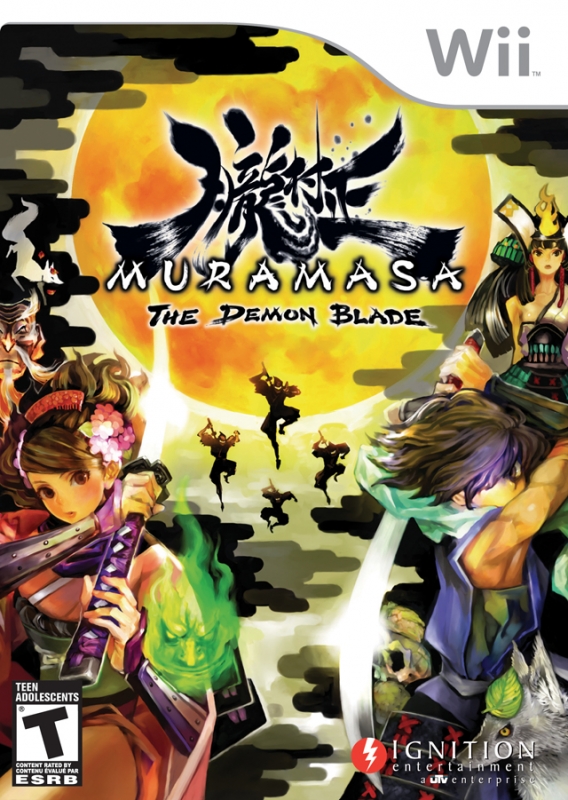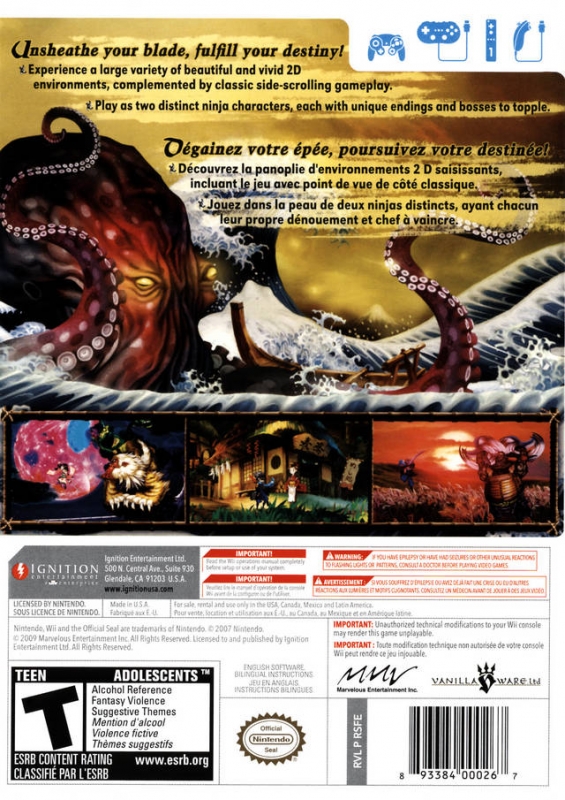Existing User Log In
New User Registration
Register for a free account to gain full access to the VGChartz Network and join our thriving community.





America - Front


America - Back

Muramasa: The Demon Blade, the latest game from Vanillaware, draws players into an elegant and action filled adventure set in the Genroku Age of Japanese history. This is a game that stands out for its artistic quality, personality, and an amazing display of how 2D images can still have some life in the videogame market.
The game is based on the legend of Muramasa Sengo, a katana forger well-known in his province during the Tokugawa Shogunate because of the extraordinary sharpness of his swords.
Sengo had a dubious reputation for being bloodthirsty and it was said that anyone who wielded one of his blades was engulfed by an uncontrollable lust for blood, to the point that every time the owners drew one, they felt the need to wet it in human or animal entrails before sheathing it again. Refusing to do so would lead the wielder to the point of insanity and suicide. Thus the name Muramasa came to be associated with the viler and more brutal aspects of the samurai calling.
So it shouldn’t come as a surprise that Vanillaware, creators of Odin Sphere, and GrimGrimoire, developed an interest in this legendary plotline and christening it as the inspiration for their latest Japanese mythology game.
Muramasa: The Demon Blade is essentially a “beat ‘em up” game with some role-playing elements, which are mainly centered on the level up of your characters by experience points and the use and managment of equipment like weapons and accessories. The storyline in the game is divided between two characters, two ‘heroes’ that traverse opposite paths; unknown to each other at first, but destined to eventually meet. Kisuke embodies the mythical samurai fleeing his past, while the beautiful lady Momohime, for reasons beyond her control, has ended up with one of Muramasa’s blades and is now in a desperate quest to find a way to free herself from the bloodlust that comes with these cursed weapons.
It’s up to the player to decide whether they want to begin with Kisuke or Momohime. Their fighting styles are similar, but the storyline is very different. Also, at the beginning you can choose between two difficulty settings: Muso or Shura. In the first, there is automatic target lock-on, and enemies are taken down easier, while the second one is more difficult overall. If you originally decide to start with Shura, but halfway through you realize it’s too difficult for you, don’t worry, you can change to the other mode at will.
The game sports a tedious tutorial that is nonetheless essential to dominate the varied battle arts of each character. Action is not limited to throwing sword jabs hither and thither; we actually have to calculate our timing well in order to unleash the special combo moves for each of the three blades carried by each character.
The abilities of each character are essentially the same. The main variants are that as you level up via experience, you obtain better attack and defense stats for the same moves. In fact, you really don’t get any faster or sleeker new moves. Instead, one must also rely on the evolution of the Muramasa blades, which become protagonists on their own right in the gameplay. At a certain point in the story, it is possible to have Muramasa himself forge a sword for you. However in order to achieve this one must collect the souls left behind by fallen adversaries. We also receive ‘Spirit Points’ every time we feed our character. These collected souls and spirit points are the basis to force the legendary forger to work for us, as he is now a cursed ghost himself destined to toil in the afterlife for the sins and excesses committed in his lifetime.
Muramasa: Demon Blade does not use the Wii motion sensing capabilities, and instead offers three possible alternate control schemes: Classic Controller, GameCube Controller, and Wiimote & Nunchaku Controls. After trying out all three of them, I leaned towards the first option, which offered me the best combination of responsiveness and comfort.
The play scheme borrows on elements from games such as Metroid, in which you can traverse the world unimpeded until you find the necessary elements to advance through some barriers. In the case of Muramasa, these barriers are of a magical nature, and can only be sorted by using the correct weapon. These weapons are usually obtained after defeating certain bosses. Thus, these boss weapons also double up as keys that open specific magical gates that lead to new provinces. So the gameplay consists of searching for a new boss, defeating him, breaching the barrier that blocks access to a new zone, and then repeating the process all over again. Fortunately, this pattern is well seasoned with a series of unique elements that make it a very palatable dish for players.
Muramasa has two combat styles: fast and agile katana slashes that are not too lethal, and slower, more forceful blows that pack more demolishing efficiency. Throughout the story one can gather up to 108 different weapons, each geared for a special ability (swinging attacks, vertical strikes, spiral blows, etc.). You must be careful to choose the one best suited to counter each enemy’s fighting style. One of the great virtues of the Muramasa blades is their resilience, so despite not being indestructible they can take a remarkable amount of punishment without breaking. Thus, knowing when and how to defend is also an important issue to keep in mind; a strategic retreat up a tree or nearby building is occasionally advisable in order to guard the integrity of the weapon we carry. Broken swords must be sheathed and allowed to slowly restore themselves before we can use them again.
Bosses are generally gigantic, with outstanding presentation and colorful design. Fighting one is usually one of the toughest and longest tasks of your journey. Bosses are the most frequent responsible parties for your broken swords, and it is always a very tense wait when you’re forced to sheathe your damaged weapon and just dodge about the screen to avoid their attacks while you wait for your blade to heal. The save points are spread all over the main map, and there will always be one handily around before a boss battle. This means that at least you’re not excessively punished for losing a life during these battles since the game will restart very close to the boss if you choose to continue with your next life.
As mentioned, you need spirit points to get new weapons forged. This is where the kitchen comes into play. There is a small, but entertaining Kitchen Mini-game in which if you have both the ingredients and the recipe (recipes can be bought in the villages, just as the regional maps) you can cook up exquisite dishes that provide you with energy and spirit points. However, if you don’t want to cook, there are small restaurants in the towns where you can purchase food for a reasonable cost. Do note that the game has a ‘Fullness’ bar that if filled, will not allow you to eat anymore until it begins depleting again.
Muramasa: Demon Blade is doubtless one of the most beautiful and artistic games that decorate the Wii annals, particularly in the visuals department where it is a true masterpiece. All the scenarios, from forests, to giant waterfalls, to rural walkways are overflowing with hand-drawn details and jaw-dropping special effects. The characters and enemies present a level of variety, colorfulness, and detailed. Indeed a masterpiece of aesthetic design.
In the sound department, Muramasa presents oriental background tunes that turn placid when you visit a village and become frenetic during battles. All of the game dialogues are spoken in Japanese and subtitled into English, a fact that actually helps it to achieve that oriental myth feel. The subtitle dubbing is excellent, so overall it seems like a good executive idea to keep the original voices in the game.
Regarding game value, Momohime's and Kisuke's stories take around 9 hours each, plues the game adds in six different possible endings which require some 30 more hours to unlock. Finally, for completionists, there is always the challenge of aquiring the full set of 108 weapons, and that of course requires even more play hours. So there is enough content in Muramasa to last you for a while.
But Muramasa does stray slightly short from being the perfect game. The aforementioned scenarios previously praised for their beautiful detail tend to be repeated quite often, costing it a few points in my review. After all, no matter how beautiful a painting might be, after a while of seeing it popping up before you over and over it tends to lose its charm. Another annoying aspect is all the unnecessary backtracking you have to do. You often have to retrace your steps through previously cleared territories to complete a new task after defeating a boss. I feel it cuts the pace of the action; this is particularly true near the start of the game. Other critiques worth mentioning are the linearity of gameplay and the superficial differences between weapons (despite changing swords, our hero’s abilities remain the same, and even some of the special moves of the various swords look suspiciously similar and are occasionally quite useless).
Muramasa is doubtless one of the most enthrallingly beautiful games in the Wii’s catalog. Before I started playing I wondered if this title would end up being a visual art piece with little fun and gameplay packed into it. Now, after playing it, and having been satisfied to the point of ecstasy by so many hours of gameplay, I admit the game achieves a near perfect balance between raw entertainment and visual awesomeness. Muramasa: The Demon Blade is a game that shouldn’t be absent from the personal collections of any Wii owner, or of anyone who appreciates truly artistic design.










|
|
|
|
|
|
|
|
|
|
|
|
|
|
|
|
|
thetonestarr
posted 06/09/2011, 01:01
I love this game. It's a LOT of fun, and it's breathtakingly gorgeous too. Message | Report |